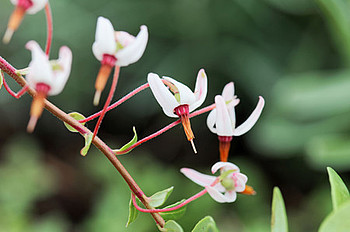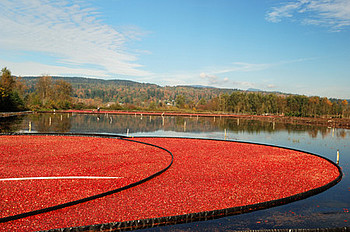The origin of the cranberry
There are many berry varieties in Germany, but the cranberry stands out especially because of its name. Although it is also cultivated in Germany today, the fruit originally comes from North America. There it has long been used by the indigenous peoples of North America. With the European settlement of North America, the knowledge about the berries and their processing was passed on to the European settlers. Thus, the cranberry has become an important part of today's North American food culture. Especially in autumn and winter, for example at Thanksgiving, it is often found as part of the dishes.
Good to know: where does the name "cranberry" come from?
The name cranberry dates back to the time of the European settlers, because the flower of the bush reminded them of a crane's beak. That is why they originally called the bush and its fruit Crane Berry. Over time, this name was shortened to the current name cranberry. The botanical name of the plant is Vaccinium macrocarpon and tells us that the cranberry belongs to the blueberry genus.
What the cranberry looks like and where it is grown

The cranberry is deep red when fully ripe and about the size of a cherry. It grows mainly in North America, but can now also be found on cultivation areas in Germany and the Netherlands. The cranberries for our Rabenhorst juices come from North America. This is because we want to maintain the long-term and cooperative relationships with our growers, who have always supplied us with fruit of the highest quality.
The cranberry prefers a poor, sandy to boggy soil. There the bush then grows close to the earth and likes to spread. Because of the soil, the cranberry is cultivated in Germany, for example, on the edge of the Lüneburg Heath. In spring, the bush blossoms pink with flowers that have earned the plant its name cranberry. From these, first a small white berry develops, which in time ripens to green and then to the characteristic red colouring. The harvest time is in autumn, mostly September and October.
Harvesting the cranberry

The harvesting of the cranberry is special in the USA: here the fields are first flooded and then the ripe berries are pulled from the bushes by a fortex suction with the help of special machines. Since the berries consist of four air chambers inside, they float on the surface of the water and can thus be easily collected and purely checked for ripeness: there is a "bounce test" where the cranberry has to bounce over a barrier to pass the quality control. This works well, because unripe and damaged cranberries do not bounce so well and can thus be easily sorted out.
Typical processing forms of the cranberry
As the cranberry is still very sour and somewhat bitter when ripe, it is rarely eaten unprocessed. That is why the cranberry is often found in dried form, processed as juice, jelly or compote. In addition to the fruit, you can add cranberry juice to the jelly for a stronger flavour.
A delicious and versatile processing form of the cranberry is the juice. For our cranberry juice, we only process berries that have been grown as sustainably as possible and have passed a strict quality control. The cranberries are then only pressed once, resulting in a high-quality pure juice from first pressing.
FAQ
What is the difference between cranberry and cowberry?
Cranberries and cowberries are related as heather plants, but differ greatly externally. While the cowberry bush grows upright, the cranberry bush climbs along the ground. The fruit also looks different. The cranberry is about the size of a cherry and bright red, the cowberry is smaller and grows in clusters on the bush.
How can you consume cranberries?
Cranberries are quite sour when unprocessed and are therefore processed as juices, jellies and compotes or eaten dried.

